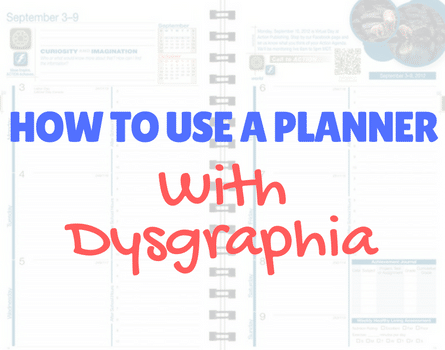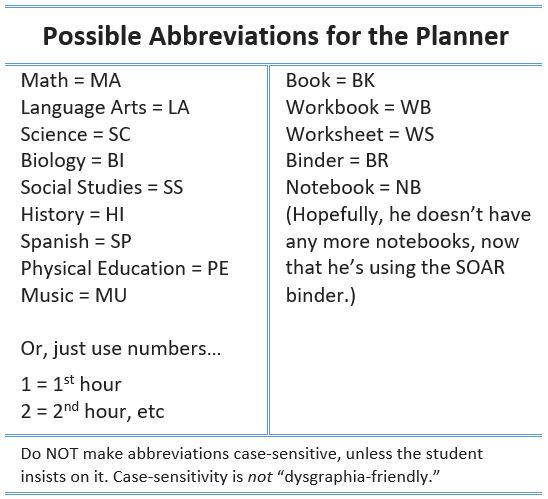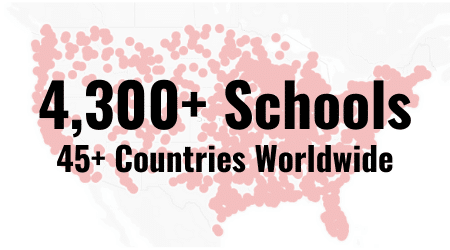How to Use a Planner… with Dysgraphia
I was recently asked by a tutor using SOAR, how to help a student who has dysgraphia use a planner. (Dysgraphia is an extreme difficulty with writing.) It’s such an important question, I wanted to share my response with you.
Q: Do you have any suggestions for my student who has dysgraphia and has difficulty writing in a planner? Writing is such a struggle for him, by the time he opens his planner, he’s so overwhelmed, he doesn’t know what to write!
A: Oh, what a good question!
My son has dysgraphia, so I know –with my heart and soul– how difficult writing can be for these students. I have seen my bright and brilliant child shrivel over a “simple” writing assignment.
Dysgraphia (difficulty with writing) and dyslexia (difficulty with reading) are two different symptoms with one shared cause… a weak “working memory.” This means the brain does not recall the sound-symbol relationships of letters as automatically as you and I do.
A weak working memory means that every letter requires painstaking recall just to visualize the letter. Writing the letter then becomes more like a process of drawing as they attempt to recreate the letter.
A weak working memory also means that spelling is a major challenge! Especially in English, which seems to have more “exceptions” than rules.
So, when you combine these challenges together… and then expect the student to formulate and express thoughts simultaneously, you can understand why writing is so overwhelming!
However, we can also use this understanding to navigate some solutions…
KEY QUESTION: “How Can We Reduce Demand on the Brain?”
Step 1: Make the Planner Easy to Access.
If you’re following the SOAR system for using the planner, then he already has a pen/pencil in the spiral of the planner. He also has a binder clip securely marking the current page for instant access. These steps seem too simple to matter. But, they have a MAJOR impact on reducing strain on the brain.
Step 2: Clarify/Simplify What He Should Write.
This step seems so obvious to us, as adults. But, until this very moment, I never thought about how important it is for us to explicitly break this down for our students.
Every assignment entry in a planner should follow the same formula:
Subject/Class – Assignment – Books Needed
The same three things. Every time. That’s it!
NOTE: The planner is no place for any student to record directions for an assignment. All “directions” should be in writing from the teacher and placed in the Binder. If he is feeling the need to write more in the planner than the three items listed above, it may require some intervention with the teacher. I have run into this problem on rare occasions. In this case, I call on the teacher to provide additional support.
Step 3: Reduce Writing with Abbreviations and Symbols.
He will need some coaching to help him create abbreviations. Start by explaining that the goal is to reduce the amount of writing he needs to do.
Then, ask him, “What’s the first thing you think of to shorten the word, “Math”? etc. I included some potential abbreviations below. However, it’s very important to start with what automatically comes first to the students’ mind. (Memorization is NOT a strength for someone with a weak working memory.)
Perhaps he will prefer to draw symbols instead of using abbreviations, especially for the type of books. WHATEVER works for him.
Once you’ve developed a list of abbreviations/symbols, you may want to tape the list into the front and back cover of the planner for easy reference, until they become automatic for the student.
Remind him that his planner notes only need to make sense to him. He is not being graded on his planner; he only needs his notes to serve as a reminder of all he has to do.
Step 4: Pull It All Together.
Have him practice using his abbreviation/symbols to record homework assignments. Remind him of the simple 3-item formula:
Subject/Class – Assignment – Books Needed.
His planner entries might look something like this:
MA – pg 122 1-25 odd – MA BK
(Instead of “Math – page 122, problem #s 1-25, odd – Math Book”)
OR
SC – WS – BR
(Instead of “Science – worksheet – binder.” If he’s using the SOAR binder, he’ll know that the “ws” is in the front pocket of his binder.)
OR
HI – WB p 5-57 – HI WB (Instead of “History – Workbook page 5-57 – History Workbook”)
Step 5: Circle all BOOKS NEEDED.
When he gets to his locker at the end of the day, he can *quickly* see how many books he needs at home and can quickly grab what he needs.
What If These Steps Don’t Work?
Expect to spend some time coaching your student through this process. I expect the abbreviations may require some trial-and-error.
However, if he still struggles or if his frustration only grows, there is always technology. Since smart phones are rarely out of our students’ reach, a “homework planner” app could be a viable option. The most popular homework planner app on iTunes is “The Homework App” by Kerman Kohli.
However, I generally like to avoid the use of electronics in place of a paper planner. Yes, you read that right…
Electronic apps are NOT optimal for the process of “homework planning.” I explain my reasons in more detail in this post about smart phones vs planners.
The primary reason I am not a fan of using a homework planner app is the inherent distractions on any phone. How many times do you pick up your phone to do one thing, only to get distracted by a text or a notification or a headline…? It’s no different for our students.
Another major concern is that you can’t see a full week at a time on a smart phone. The weekly view is key for students to be able to visually “map” their responsibilities into their week.
Also, research shows that, for most people, writing with a pen/pencil activates the regions of our brain that manage thinking and planning. “Writing” with finger tips (or thumbs) only activates the “language” areas of our brain.
So, I generally want to find a way to make PAPER planners work.
However, I also believe there are exceptions to every rule. At the end of the day, it is important for your student to find success in whatever way works best for him!
Good luck! And, thanks for the question. 🙂
Susan Kruger, M.Ed.
Founder & Author of SOAR
Six Steps to
Conquer the Chaos
Get Our Free Guide & Information on...

"*" indicates required fields
SOAR® in the News
The SOAR® Curriculum
The most critical learning, organizing, and communication skills needed for school. Learn more here.
Who’s Using SOAR®?
SOAR® Guarantee
Click here to learn more.







